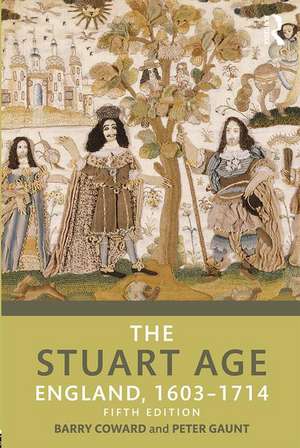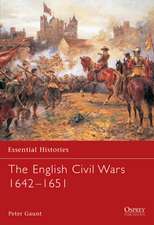The Stuart Age: England, 1603–1714
Autor Barry Coward, Peter Gaunten Limba Engleză Paperback – 16 feb 2017
| Toate formatele și edițiile | Preț | Express |
|---|---|---|
| Paperback (1) | 384.56 lei 3-5 săpt. | +41.84 lei 6-12 zile |
| Taylor & Francis – 16 feb 2017 | 384.56 lei 3-5 săpt. | +41.84 lei 6-12 zile |
| Hardback (1) | 773.26 lei 6-8 săpt. | |
| Taylor & Francis – 16 feb 2017 | 773.26 lei 6-8 săpt. |
Preț: 384.56 lei
Nou
Puncte Express: 577
Preț estimativ în valută:
73.59€ • 76.68$ • 60.93£
73.59€ • 76.68$ • 60.93£
Carte disponibilă
Livrare economică 13-27 martie
Livrare express 26 februarie-04 martie pentru 51.83 lei
Preluare comenzi: 021 569.72.76
Specificații
ISBN-13: 9781138944176
ISBN-10: 1138944173
Pagini: 650
Ilustrații: 4 black & white tables, 22 black & white halftones, 2 black & white line drawings
Dimensiuni: 156 x 234 x 38 mm
Greutate: 0.95 kg
Ediția:5th edition. Revised
Editura: Taylor & Francis
Colecția Routledge
Locul publicării:Oxford, United Kingdom
ISBN-10: 1138944173
Pagini: 650
Ilustrații: 4 black & white tables, 22 black & white halftones, 2 black & white line drawings
Dimensiuni: 156 x 234 x 38 mm
Greutate: 0.95 kg
Ediția:5th edition. Revised
Editura: Taylor & Francis
Colecția Routledge
Locul publicării:Oxford, United Kingdom
Public țintă
UndergraduateCuprins
PART 1 Early Stuart England, 1603 –1640 1
Introduction 3
1 The economy of early Stuart England 5
The population and the economy 5The optimistic case 7The pessimistic case 10Conclusion 16
2 Society in early Stuart England 18
The achievements of social historians writing in the 1970s and 1980s 19From the 1990s onwards: social history with the politics put back 35Intellectual developments and popular beliefs 38Conclusion 58
3 The Elizabethan constitution 62
The framework of government 63Stresses within the Elizabethan constitution: political and religious divisions and ‘the public sphere’ 77
PART 2 The reigns of the early Stuarts, 1603 –1640 87
Introduction 89
4 The survival of the Elizabethan constitution, 1603 –1621 93
James I and the succession 94Peace with Spain and the settlement in Ireland 99Puritans and Catholics 103James’s first parliament, 1604 –1610 110Rule without parliament, 1610 –1621 121
5 The breakdown of the Elizabethan constitution, 1621–1640 129
1621–1624: the emergence of conflicting conspiracy theories 131The prerogative ‘extended . . . beyond its just symmetry’, 1625 –1629 137The Personal Rule, 1629 –1640 146
PART 3 The English Revolution, 1640 –1660 165
Introduction 167
6 The making of the English Revolution, 1640 –1649 169
The constitutional crisis, November 1640 –September 1641 170The crisis becomes a civil war, September 1641–July 1642 182The first civil war, 1642–1646 191The search for a settlement: king, parliament, the army and the Scots, 1645 –1649 215
7 The search for a new settlement, 1649 –1660 233
The search for a ‘godly reformation’ 234The Rump Parliament, 1649 –1653 242Barebones Parliament, July–December 1653 254Oliver Cromwell 257Cromwellian government, 1653 –1658 265The end of the Good Old Cause, 1658 –1660 281
PART 4 The reigns of Charles II and James II, 1660 –1688 285
Introduction 287
8 The failure of ‘the Restoration Settlement’, 1660 –1667 291
The Convention Parliament, 1660: old wounds reopened and old problems unsolved 291The Cavalier Parliament and the restored monarchy, 1661–1664 296The Cavalier Parliament and the restored Church, 1661–1664 299The second Dutch war and the downfall of Clarendon, 1664 –1667 305
9 ‘Catholic’ or ‘Cavalier’ policies, 1668 –1674 311
10 Anti-Catholicism and exclusion, 1674 –1681 321
Anti-Catholicism 321Danby, 1674 –1678 325The Popish Plot 333The Exclusion Crisis, May 1679 –March 1681 337
11 The trend towards absolutism, 1681–1688 343
The strengthening of royal authority, 1681–1685 344James II and Protestant unity, February 1685 –June 1688 347The intervention of William of Orange, 1688 354
PART 5 The reigns of William III and Queen Anne, 1689 –1714 357
Introduction 359
12 The reign of William III, 1689 –1702 363
Politics in the reign of William III 363The Glorious Revolution, 1689 –1690 367A country at war, 1690 –1697 378Peace and politics: the collapse of the Junto, 1697–1701 397Party issues redefi ned, 1701–1702 403
13 The reign of Queen Anne, 1702–1714 409
Politics in the reign of Queen Anne 409The failure of the ‘managers’, 1702–1708 416The failure of the Whigs and Tories, 1708 –1714 440
PART 6 Later Stuart England: change and continuity 463
14 Change 465
The long-term effects of the Glorious Revolution: war and constitutional changes 465Religious and intellectual changes 474Economic and social changes 486
15 Continuity: 1714 – the end of the Middle Ages? 507
Bibliographical note 512Appendix: Timeline 532Index 565
Introduction 3
1 The economy of early Stuart England 5
The population and the economy 5The optimistic case 7The pessimistic case 10Conclusion 16
2 Society in early Stuart England 18
The achievements of social historians writing in the 1970s and 1980s 19From the 1990s onwards: social history with the politics put back 35Intellectual developments and popular beliefs 38Conclusion 58
3 The Elizabethan constitution 62
The framework of government 63Stresses within the Elizabethan constitution: political and religious divisions and ‘the public sphere’ 77
PART 2 The reigns of the early Stuarts, 1603 –1640 87
Introduction 89
4 The survival of the Elizabethan constitution, 1603 –1621 93
James I and the succession 94Peace with Spain and the settlement in Ireland 99Puritans and Catholics 103James’s first parliament, 1604 –1610 110Rule without parliament, 1610 –1621 121
5 The breakdown of the Elizabethan constitution, 1621–1640 129
1621–1624: the emergence of conflicting conspiracy theories 131The prerogative ‘extended . . . beyond its just symmetry’, 1625 –1629 137The Personal Rule, 1629 –1640 146
PART 3 The English Revolution, 1640 –1660 165
Introduction 167
6 The making of the English Revolution, 1640 –1649 169
The constitutional crisis, November 1640 –September 1641 170The crisis becomes a civil war, September 1641–July 1642 182The first civil war, 1642–1646 191The search for a settlement: king, parliament, the army and the Scots, 1645 –1649 215
7 The search for a new settlement, 1649 –1660 233
The search for a ‘godly reformation’ 234The Rump Parliament, 1649 –1653 242Barebones Parliament, July–December 1653 254Oliver Cromwell 257Cromwellian government, 1653 –1658 265The end of the Good Old Cause, 1658 –1660 281
PART 4 The reigns of Charles II and James II, 1660 –1688 285
Introduction 287
8 The failure of ‘the Restoration Settlement’, 1660 –1667 291
The Convention Parliament, 1660: old wounds reopened and old problems unsolved 291The Cavalier Parliament and the restored monarchy, 1661–1664 296The Cavalier Parliament and the restored Church, 1661–1664 299The second Dutch war and the downfall of Clarendon, 1664 –1667 305
9 ‘Catholic’ or ‘Cavalier’ policies, 1668 –1674 311
10 Anti-Catholicism and exclusion, 1674 –1681 321
Anti-Catholicism 321Danby, 1674 –1678 325The Popish Plot 333The Exclusion Crisis, May 1679 –March 1681 337
11 The trend towards absolutism, 1681–1688 343
The strengthening of royal authority, 1681–1685 344James II and Protestant unity, February 1685 –June 1688 347The intervention of William of Orange, 1688 354
PART 5 The reigns of William III and Queen Anne, 1689 –1714 357
Introduction 359
12 The reign of William III, 1689 –1702 363
Politics in the reign of William III 363The Glorious Revolution, 1689 –1690 367A country at war, 1690 –1697 378Peace and politics: the collapse of the Junto, 1697–1701 397Party issues redefi ned, 1701–1702 403
13 The reign of Queen Anne, 1702–1714 409
Politics in the reign of Queen Anne 409The failure of the ‘managers’, 1702–1708 416The failure of the Whigs and Tories, 1708 –1714 440
PART 6 Later Stuart England: change and continuity 463
14 Change 465
The long-term effects of the Glorious Revolution: war and constitutional changes 465Religious and intellectual changes 474Economic and social changes 486
15 Continuity: 1714 – the end of the Middle Ages? 507
Bibliographical note 512Appendix: Timeline 532Index 565
Notă biografică
Barry Coward was Reader in History at Birkbeck College, University of London. His publications include Oliver Cromwell (2000) and The Cromwellian Protectorate (2002).
Peter Gaunt is Professor of Early Modern History at the University of Chester and current President and past Chairman of the Cromwell Association. His previous publications include The English Civil War: A Military History (2014) and, together with Barry Coward, English Historical Documents, 1603–1660 (2010).
Peter Gaunt is Professor of Early Modern History at the University of Chester and current President and past Chairman of the Cromwell Association. His previous publications include The English Civil War: A Military History (2014) and, together with Barry Coward, English Historical Documents, 1603–1660 (2010).
Recenzii
The Stuart Age enjoys a hard won reputation as one of the best introductions to the 'British Isles' during an era of civil war and revolution. This updated edition, containing much that is new, makes the volume still more indispensable to students and teachers alike.
Dr David Ceri Jones, Aberystwyth University, UK
The late Barry Coward’s The Stuart Age, 1603-1714 has long been regarded as the best single-volume introduction to the history of seventeenth-century England. This revised fifth edition elegantly updates Coward’s work for the post-Cameron generation. The book is prefaced with an excellent new introduction by Peter Gaunt, which surveys the dizzying quantity of new writing on the subject which has appeared since the fourth edition was published, in 2012, and incisively summarises the current state of the field. Gaunt’s deep knowledge of all aspects of seventeenth-century English life makes him the ideal scholar to refresh and rejuvenate Coward’s original text - and his work has ensured that, in its latest incarnation, The Stuart Age will continue to be required reading for all who teach and study this most fascinating of historical periods.
Mark Stoyle, University of Southampton, UK
Dr David Ceri Jones, Aberystwyth University, UK
The late Barry Coward’s The Stuart Age, 1603-1714 has long been regarded as the best single-volume introduction to the history of seventeenth-century England. This revised fifth edition elegantly updates Coward’s work for the post-Cameron generation. The book is prefaced with an excellent new introduction by Peter Gaunt, which surveys the dizzying quantity of new writing on the subject which has appeared since the fourth edition was published, in 2012, and incisively summarises the current state of the field. Gaunt’s deep knowledge of all aspects of seventeenth-century English life makes him the ideal scholar to refresh and rejuvenate Coward’s original text - and his work has ensured that, in its latest incarnation, The Stuart Age will continue to be required reading for all who teach and study this most fascinating of historical periods.
Mark Stoyle, University of Southampton, UK
Descriere
The Stuart Age is an accessible introduction to England’s century of civil war and revolution. The fifth edition has been updated to reflect new work and changing trends in research on the Stuart Age. It expands on key areas including the early Stuart economic, religious and social context; key events and debates surrounding the English Civil War; colonial expansion, foreign policy and overseas wars throughout the Stuart period; and significant developments in Scotland and Ireland. A new opening chapter provides an overview of current historiographical trends in Stuart history. A long-standing favourite of lecturers and students, this is essential reading for those studying Stuart Britain.




